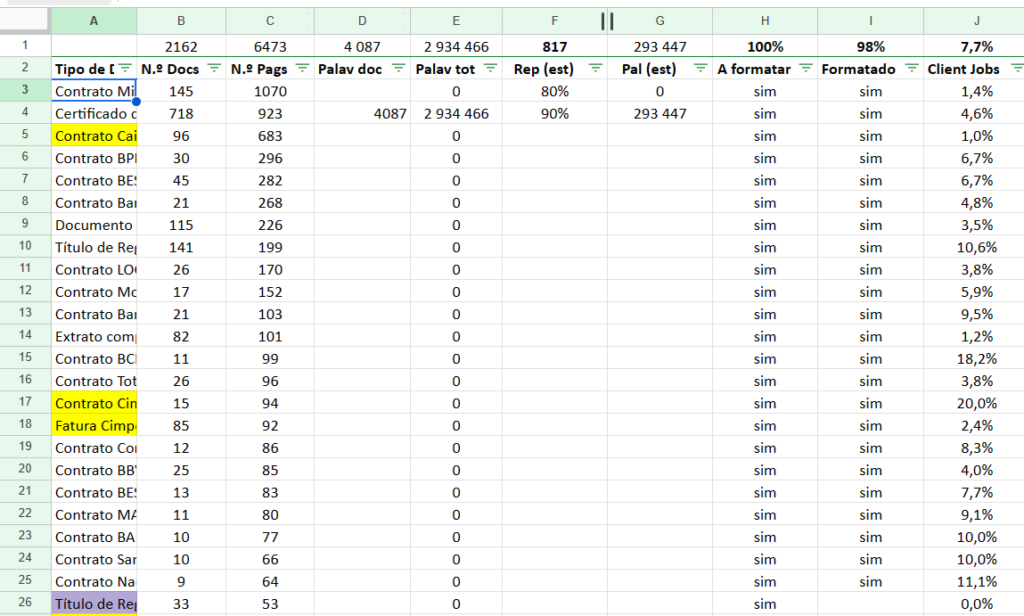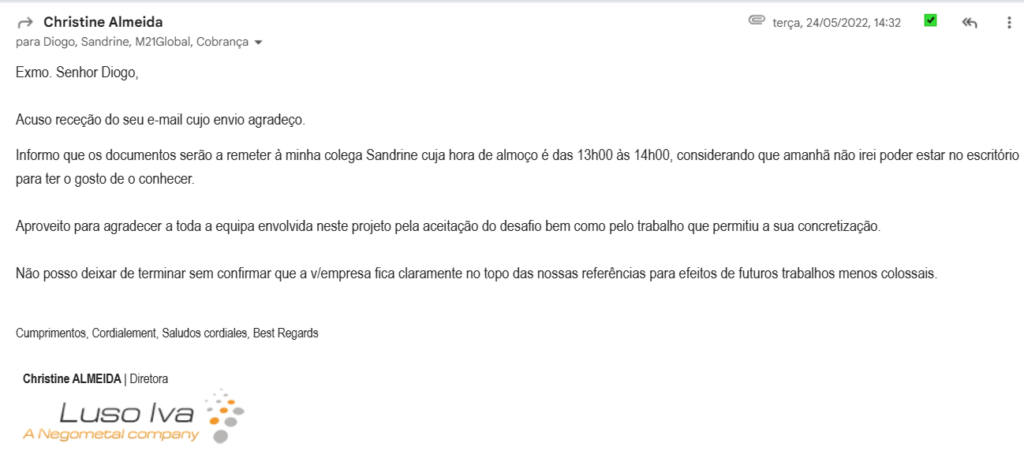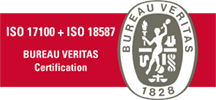In 2022, we were approached with a request for a translation project of an unusual magnitude, in terms of the volume of work involved. The project involved the translation of 2223 documents, scanned into PDF format, with a total of 6577 pages, and an estimated of more than 3 million words to be translated. The documents ranged from registration certificates, to invoices and purchase and sale contracts as well as leasing contracts, all with considerable technical requirements. In addition to the translation, the project required legal certification of the translation, all within an extremely tight deadline of 2 months.
Details and Features
- Conversion into editable documents
– Mission: Transform 6577 pages of scanned documents into Word format.
– Estimated time: 82 working days, considering an average of 6 minutes per page. - Translation of Millions of Words
– Mission: Translate approximately 3 million words from Portuguese to French, maintaining the accuracy of legal contracts.
– Estimated time: 1333 days of translation, considering a rate of 3000 words per day. - Printing Thousands of Documents
– Mission: Print a total of 13 154 pages, including the original documents and their respective translations.
– Estimated Time: An operation lasting 1 and a half days, considering a speed of 22 pages per minute, which is only within the reach of fastest printers on the market. - Translation Authentication – granting legal value to documents
– Mission: Certify the translations of 2223 documents, ensuring the legal validity of each one.
– Estimated time: 23 days of work, with an average of 5 minutes dedicated to each document. - Client needs: Beyond the total estimated timeframe
– Mission: To ensure delivery within the time available to the client, delivering the project in just 13 weeks.
– Estimated Project Duration: An epic battle of 1440 working days, 8 hours a day, with no rest or days off. It would take 23 professionals to deliver the project within the client’s stipulated deadline.
The challenges
On average, we translate around 1 million words every month. Accepting this project meant that for 3 months we would have to triple our translation capacity.
The enormity of the project was undeniable. To put it even further into perspective, a professional translator, with considerable experience, has the ability to translate around 3000 words per day. In other words, if this project were assigned to a single translator, it would require a commitment of more than 3 years, without days off or vacations, to finish the job.
Even with the support of artificial intelligence-assisted translation tools, it would take a translator around 1 year to translate all the documents.
Furthermore, this wasn’t the only project we had going on. The remaining almost a million words per month from other customers would have to continue to be translated.
To make matters worse, translators don’t just translate into any language, they translate within their language pair. Although we translate around 1 million words per month, only around 100 000 words of this volume are translated from Portuguese to French. This project meant the need to multiply translation needs by 20 in a single month.
These calculations serve to underline the magnitude of this project, and the extreme pressure it would put on our human and technological resources.
But even before we can start translating these documents, it would be necessary to convert them into an editable format, so that we can use the computer translation assistance tools.
We had more than 6000 pages in PDF format. Paper documents that were digitised, some dated back to the 90s in the last century, and digitisation was poor.
The need to convert documents into Word format is linked to the need for using computer-aided translation tools, in order to optimise the translator’s time. Before the existence of what we call CAT Tools (Computer-Aided Translation Tools), translations were done on a typewriter. A professional translator might be able to translate around 1000 words per day.
At that rate, a team of 50 full time translators would be needed to complete the project within the timeframe requested by the client.
With CAT Tools we were able to cut that team by two-thirds, but it would still require us to have around 16 full-time translators.
It is in this context that translation assistance tools using artificial intelligence come into play, which allow us to further leverage the translator’s work, and which allowed us to translate this volume with just 2 translators and 1 reviewer.
But to get to that point we would still have to convert the 6577 scanned pages into Word documents before any translation procedure, a meticulous process that, in itself, would take up almost 3 months of continuous work, assuming a work day of 8 hours a day with no interruptions.
The client needed the translated and certified work to be delivered within 3 months. This deadline required the mobilisation of a substantial team of translators, proof-readers and formatters, outlining from the outset the need for a well-orchestrated strategy and meticulous implementation to ensure that each phase of the project was completed accurately and on schedule.
The nature of the documents was itself intrinsically complex given that they were legal translations. They were, for the most part, contracts and invoices originating from different entities, each with its own peculiarities and subtle variations that required meticulous attention to detail both in the formatting phase and particularly in the translation and review phases.
Management Strategies
This diversity of documents brought with it this additional challenge, which required meticulous analysis to ensure an accurate translation and consistent formatting that respected the nuances of each type of document.
Given the complexity, a team of three experienced formatters was initially formed, whose mission was to thoroughly analyse each document, identify recurring patterns and classify the documents according to the similarities found. This painstaking exercise culminated in the discovery of 148 distinct types of documents, a categorisation that proved crucial to optimising subsequent formatting and translation efforts.
We were therefore able to identify 148 templates, which allowed us to optimise the formatting of all the documents, since from these templates, it was found that the documents only needed part of the content formatted and translated from scratch.

The documents were classified into folders, each folder corresponding to one of our client’s clients. Each of these folders contained a disparate number of documents; some of the folders had less than a dozen documents, while others had hundreds of documents, the largest folder having 325 documents and 1080 pages.
It was necessary to catalogue each folder, identify what types of documents each folder had, which templates needed to be used and how many documents there were for each template.
Then, the folders were ordered according to what the documents had in common, so that it was possible to start translating the folders with the most similarities, which would be fastest to deliver, and leaving the folders with less similarities until the end, which would take longest to translate.
Once the categorisation was established, the identified document models were distributed. To ensure efficient and timely execution, an additional dozen formatters were hired. The three most experienced formatters, with the knowledge acquired during the analysis phase, took on the responsibility of formatting the 148 different document templates. On the other hand, the additional team of formatters focused on adapting each formatted template to the documents themselves.
We started with folders that had less volume and less diversity, so that they could be sent for translation, allowing time for the larger, more diverse folders to be formatted in the meantime.
This organisation allowed for an efficient distribution of the work, ensuring that the translation wouldn’t have to wait until all documents were formatted and could start in parallel, from the very first days, while the other documents were being formatted.
The fact that there were template documents made it possible to identify many repetitions, allowing for more efficient translation of the documentation. It had been identified that many words and phrases were repeated throughout the documents, and this categorisation allowed for a more structured and efficient approach in the following project phases.
The modular approach, the expansion of the team of formatters, and working in parallel proved to be effective strategies for managing the colossal workload, but also keys to ensuring the demanding deadline as well as making sure that quality and accuracy were not compromised at any stage of the process.
Therefore, this timely identification of the template documents, and that they were similar to each other, and the formatting by modules, allowed time and economies of scale to be saved, having detected the extent to which the documents had repetitions among themselves.

It was thereby verified that the translation volume would effectively be 616 thousand words, with 2 and a half million repeated words, which did not require translation. It was only possible to leverage this volume of repetitions thanks to the available IT tools, good work organisation, and the timely formatting of all documents.
The documents in question were predominantly translations of purchase and sales invoices, but also of automobile registration documents, documents that, by their nature, required meticulous and detailed attention.
Furthermore, the additional existence of purchase and sale and leasing contracts increased the complexity of the work, as these are documents that, given their legal and technical nature, required an advanced command of legal terminology on the part of the translation teams, challenging us to apply a mix of logic and organisation, but also technical, legal and linguistic competence to guarantee accurate and correct translations.
Use of Technology
As mentioned, the use of computer technology, namely Translation Memories and Artificial Intelligence, has made it possible to speed up the translation process without compromising the quality of work.
A translation project, particularly of this nature, requires a guarantee of quality that cannot be compromised by the urgency of delivering the work.
This quality is guaranteed by the use of glossaries, which are generated semi-automatically and then edited and revised by the project’s translation team.
The use of a glossary in any translation always brings advantages, but particularly in a context of high technical complexity and precision, as is the case with legal translations, the use of a glossary has proven to be decisive.
The use of glossaries makes it possible to maintain terminological consistency between documents, ensuring that technical and legal terms are translated consistently throughout the document and the project; the quality of the translation is improved, ensuring that legal terms are translated correctly and in a manner appropriate to the context, also reducing the likelihood of errors and misunderstandings in the translation.
In the case of this specific project, glossaries also bring additional advantages, when we have an urgent need for time available with a translation, glossaries allow for a more efficient use of time. By having a repository of terms and their respective translations, translators can work more quickly and efficiently, facilitating proofreading and quality control, making the whole process more efficient and faster.
Therefore, all these technological developments, with the creation of glossaries, the use of translation memories and the use of artificial intelligence allow, instead of the 1000 words per day produced by the translator on a typewriter in the 90s, or the 3000 words per day produced by the translator with translation aid tools from the past decade, current technology allows professional translators to increase their translation capacity to around 10,000 words per day, or the work of 2 translators and 1 proof-reader, to deliver within the deadline requested by the client. A substantial improvement, when compared to the 50 translators with a typewriter, or the 20 translators without access to artificial intelligence.
It was the use of state-of-the-art technology that not only boosted productivity, but also ensured remarkable consistency in the translations, thanks to the use of glossaries that guarantee accurate and consistent translation, and Translation Memories, capable of reusing previously completed translations, allowing for terminological and stylistic consistency throughout all documents.
Quality Assurance
Ensuring the quality of any translation project is key to the satisfaction of our clients, but it is particularly challenging in projects of this magnitude. We faced a complex task that required a meticulous and structured approach.
During the first phase, when we divided the documents into templates, which were formatted by the most experienced formatters, we check the formatting of the remaining documents through sampling; more frequent sampling at the beginning, then more spaced out as quality is verified over time, thereby ensuring that all documents for translation were in accordance with their digital versions.
We then established a robust translation quality control system that included the implementation of project-specific glossaries and translation memories. These features enabled us to not only maintain terminological consistency across all documents, but also to speed up the translation process, ensuring that terms and phrases were translated uniformly across the entire project. Additionally, each project phase was monitored by dedicated project manager teams supported by the review team, whose experience and technical knowledge were crucial in identifying and correcting any inaccuracies or inconsistencies, ensuring that each document reflected the highest standard of quality.
Quality management is guaranteed by our policy of continuous feedback and transparent communication between all team members. By holding regular meetings to discuss the challenges encountered, and share the best practices that each person has found to overcome them, and therefore adjust approaches, as necessary.
Our artificial intelligence tools and assisted-translation software helped us monitor the quality and efficiency of the translation process in real time. This integrated quality management system not only allowed us to maintain the linguistic and technical integrity of the documents, but also ensured that each stage of the project was completed within the strict deadlines set, without compromising on quality.
Delivery and customer satisfaction
A phased delivery strategy was adopted, first with the folders containing fewer different types of documents. This approach allowed crucial additional time for formatting and translating the remaining folders, ensuring each document received the attention it needed without putting excessive pressure on deadlines. This method not only allowed effective management of time and resources, but also provided the client with partial deliveries, facilitating review and approval in stages, instead of a massive, and perhaps rushed, delivery at the end of the project.

Weekly delivery deadlines were established, and every Friday we delivered a new instalment of documents.
Therefore, despite all the existing technology, a translation project does not only depend on translators and proof-readers, but also includes project managers, terminologists, and IT technicians, who allow this entire team to communicate and share information in a simple and precise way. Therefore, a robust and multidisciplinary team of around 20 professionals was created.
This meticulous structuring of the team not only ensured an effective division of labour, but also ensured that each project phase was implemented with maximum precision and efficiency, culminating in timely project delivery, in accordance with the client’s expectations.
The stipulated deadline of 13 weeks was strictly adhered to, a testament to the precision in planning and execution that went into each phase of this huge project. Not only was the project delivered on time, but each document went through a meticulous review and quality control process, ensuring accurate and correct translation.
Subsequently, each translated and formatted document was printed, signed and legally certified, as required by the client. This was an additional challenge in itself.
In 2022 we authenticated the translation of 3349 documents, 66% of which related to this project.
After certification, the documents were carefully scanned and prepared for delivery to the client. This final process not only ensured the preservation of document integrity, but also facilitated document delivery and access by the client.
The client’s total satisfaction upon receiving the translated, formatted, revised, certified and scanned documents, reflects the high standard of professionalism and uncompromising dedication to quality that characterise the services provided by M21Global. This experience reiterates M21Global’s unique ability to manage complex and substantial translation projects, even under tight deadlines, guaranteeing quality and accuracy at every stage of the process, fully meeting the client’s expectations.

Conclusion
The successful completion of this translation project not only reinforced our reputation as leaders in the field of translation, but also provided us with valuable insights for future projects. One of the most significant lessons was the importance of careful, but flexible planning, which allows us a degree of adaptability to unforeseen events. The ability to quickly adjust work strategies in the face of unexpected challenges proved essential to the success of this project.
We also learned the immeasurable value of clear and constant communication, both within teams and with the client, to ensure that everyone involved was aligned with the project’s objectives and progress.
This project has enriched us as a team, allowing us to realise, all together, the capacity we have to manage projects of this magnitude. It showed us our skill set and prepared us for large-scale and complex projects.
We realise the importance of continually investing in team training and development, and also in the constant updating of our technological tools, which allows us to remain a reference company in the translation sector.
It has also reinforced our belief in the importance of building solid, long-term relationships with clients, based on trust and the consistent delivery of high-quality results. We are confident that the lessons learned from this project will be key to our continued success and overcoming the challenges that the future holds.

